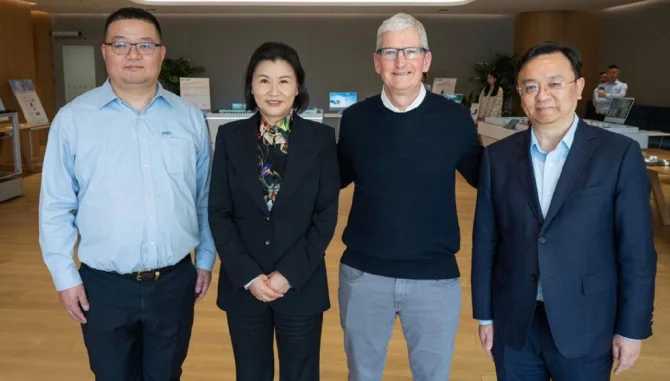On November 25, Apple CEO Tim Cook attended the 2nd China International Supply Chain Expo. This marked his first appearance at the event and his third visit to China this year. Speaking at the expo, Cook emphasized, “Apple wouldn’t have achieved its success today without our Chinese partners.” Notably, Apple’s booth prominently displayed the statement: “Over 80% of Apple’s 200 major suppliers produce in China.”
This stands in sharp contrast to Apple’s previous efforts to reduce its reliance on China by diversifying its supply chain—a strategy commonly referred to as “de-Chinafication.”

Cook’s Frequent Visits: A Shift in Strategy
Cook’s three trips to China this year signal a growing interest in maintaining strong ties with the country.
• March 2024: Cook’s first trip of the year saw him unveil Apple’s flagship store in Jing’an, Shanghai, an investment of over 83.4 million yuan. He also met with major suppliers like BYD’s Wang Chuanfu, Lens Technology’s Zhou Qunfei, and Changying Precision’s Chen Xiaoshu, stressing that “China is unmatched in importance for Apple’s supply chain.”
• October 2024: During a Beijing visit, Cook met with China’s Ministry of Industry and Information Technology officials, committing to increasing investments in China and strengthening the supply chain’s high-quality development.
Apple’s reliance on China is undeniable, with its vast consumer market, supportive policies, and growing middle class making the country both Apple’s largest overseas market and its most critical production hub. However, as Apple reaped benefits in China, it also pursued a “de-Chinafication” strategy—one that has proven challenging.
The “De-Chinafication” Setback
Since 2019, Apple has worked to relocate parts of its production to India, Vietnam, and other countries. It even aimed to manufacture 25-30% of iPhones in India. Yet, the results have been underwhelming.
For instance, the India-made iPhone 15 faced a wave of returns due to quality issues, forcing Apple to slash prices significantly. With such hurdles, Apple has been compelled to re-embrace China as a reliable “safe harbor.” This year, some of Apple’s production has returned to Chinese manufacturers like BYD and Luxshare Precision, both now part of the iPhone 16 supply chain.
However, Apple’s indecision appears to have cost it market share in China.
Competition from Domestic Brands
Apple’s latest earnings report (Q4 FY2024) showed revenue of $94.93 billion, exceeding analysts’ estimates, with a net profit of $14.736 billion. Yet, the performance masks its struggles in China.
Apple’s revenue from Greater China not only fell short of expectations but also declined slightly compared to the previous year. In Q3 2024, domestic brands like Vivo, OPPO (including OnePlus), and Xiaomi dominated China’s smartphone market, pushing Apple out of the top five and into the “others” category.
In a bid to regain market share, Apple offered significant discounts during China’s “Double 11” shopping festival, slashing prices on the iPhone 16 series just one month after its launch. This was the first time Apple officially discounted a new product so soon after release.
Apple’s Reality: No Success Without China
Cook’s appearance at the Supply Chain Expo, coupled with his public praise for China’s supply chain, reflects Apple’s acknowledgment of its dependence on the country. At the expo, where nearly 700 exhibitors from 69 countries gathered to discuss global cooperation, Apple’s booth prominently stated: “80% of major suppliers produce in China.”
Rather than merely “courting” China, Apple seems to be admitting an undeniable truth: Apple cannot succeed without China.
As debates about “de-Chinafication” continue, Apple’s actions serve as a lesson for other companies: the strength and reliability of Chinese manufacturing remain unparalleled.
For more insights and global news, visit DailyNewspapers.in.